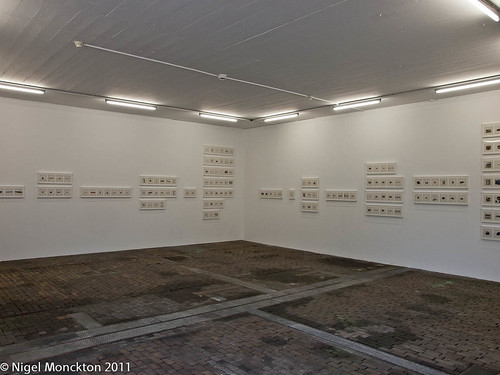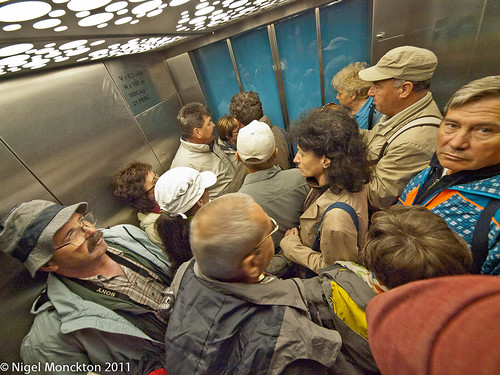Been in Switzerland on holiday for two weeks. While in Geneva I took the chance to visit the Centre d’Art Contemporain, the Musée d’Art Moderne et Contemporain and the adjacent Centre de la Photographie , which between them had a couple of photo exhibitions as well as a couple of shows by other artists and a punk and minimalism exhibition from their archives.
The Idea of Africa (re-invented)
The Centre de la Photographie was hosting a curated exhibition featuring photography from Nigerian photographer J.D. ‘Okhai Ojeikere and the artistic collective ‘Invisible Borders’ who appear to be a mixed group of photogs and film-makers.
J.D. ‘Okhai Ojeikere has some international renown for his fashion photography, in particular his interest in hairstyles, but these works were drawn from his private photography taken over the last 60 years documenting modern Lagos. The ‘Invisible Borders’ contribution was captured on a road trip from Lagos to Dakar and focussed on the ‘humiliations, bureaucracy, corruption and crime’ experienced when crossing Africa by land.
According to the press release which accompanied the exhibition ‘The Idea of Africa’ is a book by Congolese philosopher (V.Y. Mudimbe) which shows how the way we conceive Africa can be traced to Western colonial ideology. The (revisited) references the exhibitions attempt to to trace another history – one not framed on Western assumptions.
I’m afraid I struggled. With this introduction I was expecting something that would make me look again, perhaps even re-evaluate my perception of Africa.
Unfortunately, what I think I got was a selection of black and white photos from the urban documentary school. The press release talks of beauty – I saw concrete flyovers and brutalist office blocks mixed with urban poverty. I felt you could have achieved the same in some poorer areas of major British cities – so I’m not sure where the re-invention fits in. If anything it reinforced my - presumably Western colonialist – views of the consequences of the overlap of western commercialism and poverty.
This is not to say that taken on their own face value the photos were anything other than interesting and they were certainly beautifully printed. I’m just not convinced they were ever intended for the purpose that the curator has put them to.
Contraband – Taryn Simon
This exhibition – in the Centre d’Art Contemporain – was the first solo exhibition by Taryn Simon in Switzerland. It featured 546 photos from a set of 1,075 photos of items detained or seized from passengers and overseas mail over a 5-day period at JFK Airport Terminal 4. All the items were classified as prohibited, undeclared, etc.
The press release makes an issue of Simon’s scientific methodology – which falls under the category of ‘trying too hard’, as far as I’m concerned. Each photo was captured, we are told, using ‘a labour-intensive forensic photographic procedure - large format camera and the same neutral backdrop for all items.’ This is ‘reinforced’ by presenting the series alphabetically from ‘alcohol’ to ‘wood carvings’.
As it happens they were hung in batches which could be viewed in several different orders and they were reproduced at about A5 so the point of all this escapes me. They certainly benefitted from being grouped under headings though, because many of the items were not easily identifiable.

Irrespective of my issues with the ‘science’, they were a fascinating set of images. I doubt a much smaller group would have had the same impact, but the sheer number and variety of items was memorable in itself. There are some samples on Taryn Simon’s website. People smuggle or carry odd things. In between the obvious – viagra, heroin, gold-dust, counterfeit handbags etc – there was dried deer penis, dried guinea pigs, cow dung toothpaste and horsemeat sausages. It was difficult to decide whether to be appalled or amused.
The work itself fits with some of Simon’s previous work which seeks to document unknown parts of daily life in America. Should you ever wonder what customs officials are handling every day this exhibition would be a good place to start.
In the press release Simon is quoted as saying that she was interested not just in the cataloguing, but also the ability of the photos to transcend boundaries –the goods were denied entry but have made it across the border as images. An interesting idea – especially as they have now been re-exported to Switzerland! I can see her point though – without the photos the objects would float in international limbo until they were destroyed and most of us would be none the wiser.
Taryn Simon currently has an exhibition at the Tate Modern in London. A rail trip is tempting.























